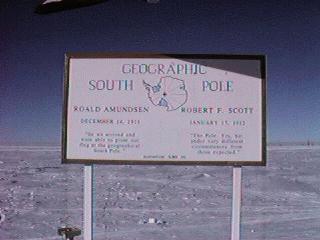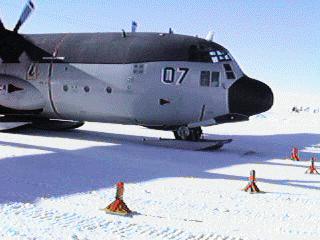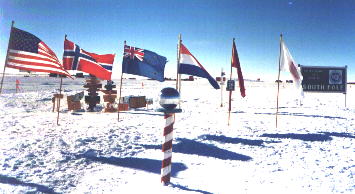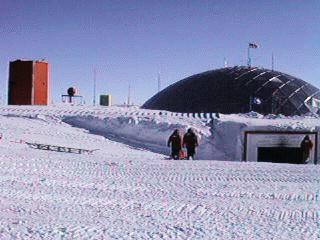

March 4, 1996
Dear Students and Mrs. Weeg:
Dave Hess Is my Winter-over co-worker in McMurdo, Antarctica. He has shared some of your letters with me. I must say that I am very impressed with the thought-provoking questions you have asked, and the amount of research that you must have done to answer some of his questions. I probably won't write as often as Dave does, but I would still like to be able to correspond with you. I will answer all of your letters, though. Recently, I bought an electronic digital camera to play with here on the Ice, so I will send some photos back to you over the Internet. I know that your letters back to me will help me make it through the long Winter.
 A few weeks ago, I completed my tenth trip to the South Pole.
Dave was stuck here in McMurdo working and going to snow school, so somebody
had to have some fun! Flying time on an LC-130 aircraft between the Pole
and McMurdo is approximately three hours. Sometimes the planes are flown by
Navy Squadron VXE-6; other times the New York Air National Guard flies them.
A few weeks ago, I completed my tenth trip to the South Pole.
Dave was stuck here in McMurdo working and going to snow school, so somebody
had to have some fun! Flying time on an LC-130 aircraft between the Pole
and McMurdo is approximately three hours. Sometimes the planes are flown by
Navy Squadron VXE-6; other times the New York Air National Guard flies them.
As I write this, I don't know if the launch has occurred or not, but in January, a Delta rocket was scheduled to be launched from Vandenberg Air Force Base in California to carry a satellite that is part of a series of satellites called ISTP. From what I understand, the satellite will be going around the sun. NASA wanted to try and track this Delta rocket at the South Pole. I was sent there to check out some equipment that I am familiar with. The launch was delayed until after the closing of the South Pole Station. Students, I need some help from you. I have no idea what ISTP stands for. Will somebody please tell me?
The objective of tracking the Delta at the South Pole is to collect the telemetry data from the second and third stage of the rocket. Telemetry is the data that is transmitted to the ground from the rocket (or satellites) that tell about the engine temperatures, amount of fuel, various pressures, etc. Usually, airplanes called Advanced Range Instrumentation Aircraft (ARIA) are used to collect this telemetry, but it is expensive to operate these planes, so NASA is looking for a cheaper way to do it. Since the equipment is at the South Pole already, it was suggested that we try and use it.
The route between McMurdo and the South Pole is over the Trans- Antarctic Mountains. Usually, the flight crews allow passengers to come up into the cockpit to take photographs of these mountains. These mountains are spectacular! Miles and miles of crevasse-filled glaciers flow between the mountain peaks. The peaks are snow-covered, while many of the sides of the mountains are just bare rocks. Various colors of blue, gray, and green can be seen in the ice. From what I understand, the Beardmore Glacier is the largest one in this group of mountains, and is part of the route that Robert Scott took when he went to the South Pole.
Scott reached the South Pole on either January 17th or 18th, 1912 (I've seen both dates published), only to see the Norwegian flag flying, planted by Roald Amundsen, who arrived there on December 14th, 1911.
Amundsen-Scott South Pole Station is operated by the United States National Science Foundation, but scientists from other countries are also encouraged to perform their research. Much of the science is so exotic that I have a difficult time comprehending it. Some of the scientists are astronomers that work there because of the cold and dry climate, and also the altitude. The average temperature there is -56 Degrees F. and the altitude is 9300 feet.
 The South Pole is located on a flat plateau. Except for the man-
made buildings, there is absolutely nothing but flat snow for hundreds of
miles in any direction. Upon exiting the plane, the first thing one sees
are the twelve flags of the original countries that signed the Antarctic
Treaty, saying the Continent would be used for scientific and peaceful
purposes. Next question: What are the names of these countries? These flags
are arranged in a semi-circle around a red-and-white pole that looks like a
candy cane. On top of this ceremonial South Pole, there is a chrome dome
which is great for taking photographs of yourself taking a photo.
The South Pole is located on a flat plateau. Except for the man-
made buildings, there is absolutely nothing but flat snow for hundreds of
miles in any direction. Upon exiting the plane, the first thing one sees
are the twelve flags of the original countries that signed the Antarctic
Treaty, saying the Continent would be used for scientific and peaceful
purposes. Next question: What are the names of these countries? These flags
are arranged in a semi-circle around a red-and-white pole that looks like a
candy cane. On top of this ceremonial South Pole, there is a chrome dome
which is great for taking photographs of yourself taking a photo.
 Looking completely out of place, the most prominent feature at the
Pole is another dome, that is 165 feet wide and 50 feet high. To the left
of this dome is an orange building called Skyway that has some scientific
labs inside. Upstairs in Skyway is an observation floor that one can see
most of the station. The radome that protects NASA's satellite tracking
antenna is also painted orange, and is located near Skyway.
A sloping ramp
of snow leads into the entrance of the dome. Above the entrance is a sign
that says, "United States Welcomes You To The Amundsen-Scott South Pole
Station". The entrance is an arched tunnel covered with frost.
Looking completely out of place, the most prominent feature at the
Pole is another dome, that is 165 feet wide and 50 feet high. To the left
of this dome is an orange building called Skyway that has some scientific
labs inside. Upstairs in Skyway is an observation floor that one can see
most of the station. The radome that protects NASA's satellite tracking
antenna is also painted orange, and is located near Skyway.
A sloping ramp
of snow leads into the entrance of the dome. Above the entrance is a sign
that says, "United States Welcomes You To The Amundsen-Scott South Pole
Station". The entrance is an arched tunnel covered with frost.
The dome is made of triangular pieces of aluminum, about 3 feet on each side. Inside the dome are three orange two-story buildings, each about the size of a house trailer. Hot chocolate is waiting inside the nearest one, the galley. Above the galley is a recreation lounge and a photo lab. The second building has the communications facility, a library and little store that double for the post office. Science labs and living quarters are in the third building. Outside this building are two smaller buildings that contain fire-fighting equipment and a green house.
The walls inside the game room has photographs and letters of-and- from Roald Amundsen, Robert Scott, and Admiral Richard Byrd. An original photograph of Amundsen at the South Pole was donated to the station by one of the five members on his historic team. The sweater worn by Admiral Byrd when he flew over the Pole in 1929 is in a glass case hanging on the wall. Representing current and future exploration, the mission patch and an American Flag flown on the Space Shuttle STS-9 mission are framed and mounted, donated by crew member Owen Garriot. Besides the South Pole sign and flags, this is my favorite place there.
During the Antarctic summer, about 145 people are at the Pole. Conditions are quite crowded, but one can eat some of the best meals on the Continent there. The people there work as scientists, carpenters, radio operators, and in many other fields. Some of the scientists are in their early twenties; others have been going there for twenty years. The experience level and enthusiasm at the South Pole is amazing.
During the Summer months, people have to stay in buildings called Jamesways. Three of them are named, "Larry, Curly, and Moe". Two others are called "Wilma and Fred". Who are those guys, anyway?
Probably twenty per cent of the people are women. They are highly skilled cargo handlers, D-9 cat operators, scientists. The Winter-over doctor sails her own sailboat to various places around the world during the off season. Of the three Summer women radio operators, one has a ranch in Colorado and has worked for the Canadians at a station near the North Pole; one is an Alaskan bush pilot; the third lady has a master's degree in zoology.
When I walked into the cargo shop looking for the NASA equipment, one lady name Sparky very excitedly told me of her disappointment in NASA not having an inter-galactic spaceship by now with people aboard. It didn't matter to her that the laws of physics prevent people from going faster than the speed of light. There was no excuse good enough for her that NASA and the rest of the space oriented people weren't making an honest effort to at least approach that speed. NASA would do well with people of her dreams and vitality saying, "Let's try this", instead of "We can't because we don't have...".
Visiting the South Pole marker and sign is always an emotional experience for me. When one is at the marker, everyone in the world is North of you. I have skied around the world there; others have walked on their hands around it. It is located about one-hundred feet beyond the flags.
One morning at 2 AM in 1988, an arriving flight was greeted by The BAMBOOZLER! Standing at the pole sign with the temperature at -35 F, wearing a Santa hat, a Hawaiian shirt, a Maori Warrior grass skirt, and thongs, my friend Dave Bieganski sold the "tourists" stepping off the plane "Drip-less Ice Cream Cones!"
On my last flight to the Pole, I took with me Bishopdale Bear, a teddy bear that is from the Bishopdale school in Christchurch, New Zealand. He had just returned from travelling around the world. He had flown to Chicago on United Airlines, then to London, where two British girls took him on an African safari. He went bungi-jumping over Victoria Falls in Africa, and white water rafting in some river. Bishopdale was given hugs and kisses by the women at the Pole, and was only allowed to drink Seven-Up at the Saturday night party. When I took him out to the Pole sign to take his photograph, the wind chill was - 75 F. He didn't say anything, but sure glared at me when I sat him on the Pole marker, which is made of brass. He was only wearing shorts and a light jacket! Then to make matters worse, I then sat him down on the snow to take his photograph at the New Zealand flag. But he forgave me when I took him back inside, gave him some hot chocolate, a South Pole patch and pin, and a Space Shuttle mission pin. Later, I will put his diary on the computer, and send it to you.
Well, it is time to close. Enclosed are some photographs of the South Pole Station. Bye for now.
Matt Nelson